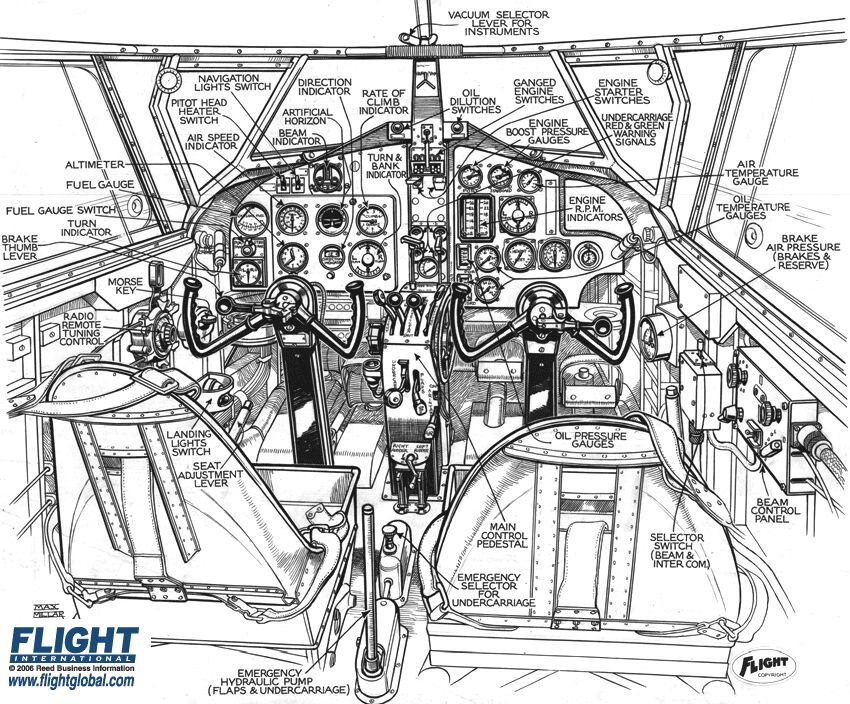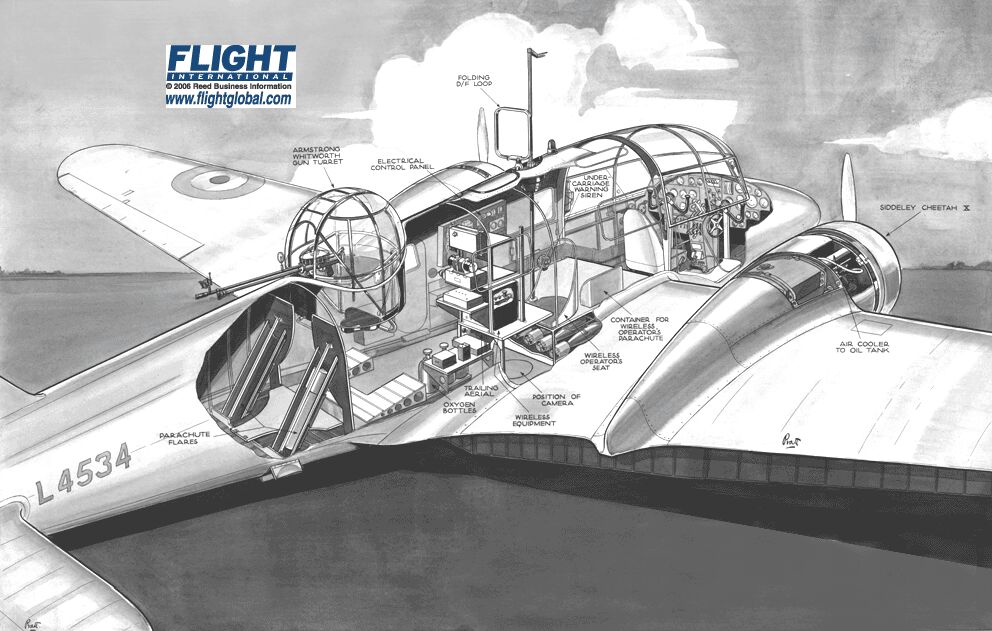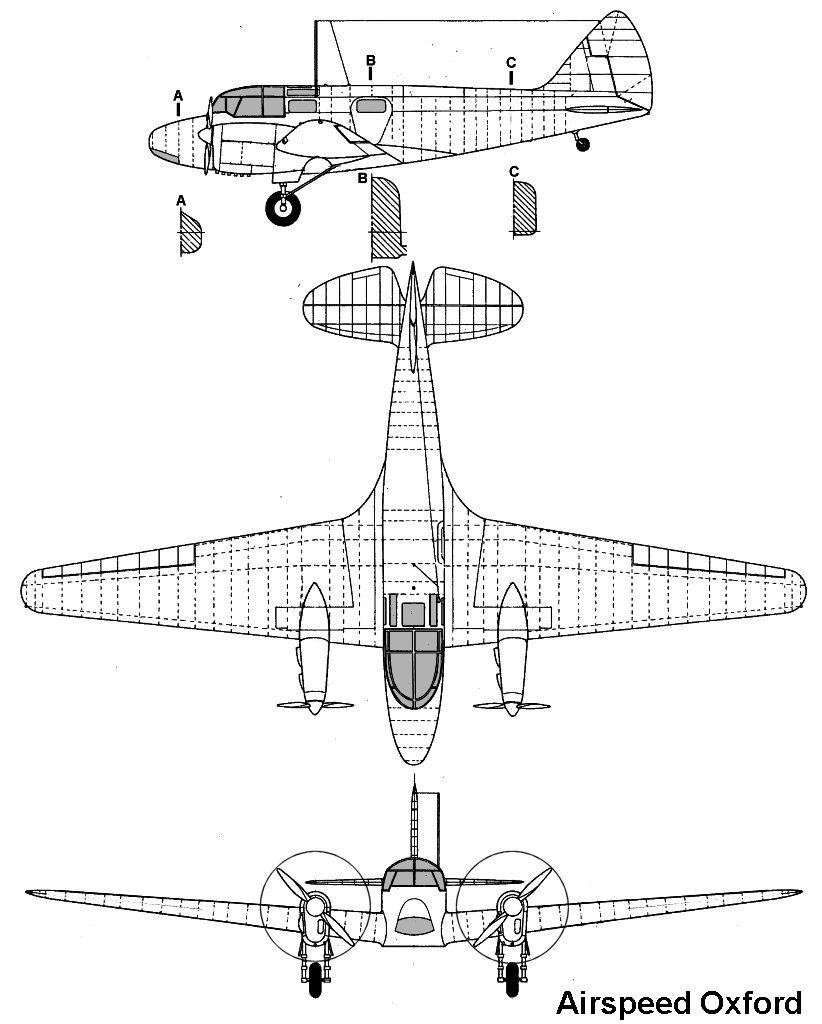Le A.S.10 Airspeed Oxford ( Hendon)
English Translation
L'Airspeed AS10 Oxford est un avion triplace bimoteur monoplan qui sert comme avion d’entrainement avancé par laRAF dans les années 1930, il a été construit suite à la note du British Air Ministry spécification n ° T.23/26 .Il est la version militarisée du Airspeed Envoy Le prototype a effectué son premier vol en 1937
Il est entré en service dans la Royal Air Force en Janvier 1938 et dans la Royal Navy en 1939/1940 . Il a servi jusqu'en 1955/56.
Airspeed Ltd
La société Airspeed Ltd est plus connue pour le planeur Horsa
Elle a été créée en 1931 à York (Royaume-Uni) par AH Tiltman et Nevil Shute Norway ingénieur aéronautique et célèbre écrivain
.jpg) |
| Nevil Shute Norway |
Racheté en 1933 par Swan Hunter, il est devenu Airspeed Ltd en Aout 1934 après le transfert de ses activités à Portsmouth ou elle concentre sa production sur les avions de transport monoplan. En Juin 1940, les parts de Swan Hunter sont rachetées par de Havilland Aircraft Company, mais l'entreprise a conservé une identité distincte Pendant le conflit Airspeed Ltd a contribué de manière considérable à l'effort de guerre avec la construction de planeurs Horsa avec près de 3800 AS51 et AS58
De Havilland étant devenu actionnaire majoritaire en 1948, la fusion entre Airspeed Ltd et de Havilland est annoncé en Juin 1951, conduisant à la formation de la Division Airspeed Ltd chez de Havilland.
.jpg) |
.jpg) |
.jpg) |
| Ancienne Usine Airspeed |
Ancienne Usine Airspeed |
Ancienne Usine Airspeed |
Mais les productions de Airspeed Ltd ne sont pas à la hauteur et le seul succès d’après-guerre, est l’'Ambassador construit pour British European Airways (BEA) il sera exploité sous le nom d’ Elizabethan
Airspeed Limited fusionne complètement avec De Havilland en 1951
Le A.S.10 Airspeed Oxford
.jpg) |
Le AS.10 Airspeed Oxford ou Ox-box est un bimoteur utilisé pour la formation des équipages à la navigation, radio-exploitation, au bombardement et de tir au cours de la 2e Guerre Mondiale L’Oxford est un bimoteur tres agréable à « conduire » et bien adaptée à la tâche de formation. Et il a été sélectionné comme avion de formation par l’ Empire Air Training Scheme (EATS) et le British Commonwealth Air Training Plan (BCATP)
Airspeed avait auparavant construit une version civile de 8 places le Airspeed AS 6 Envoy
En suivant le cahier des charges n ° T.23/26 né l'Airspeed Oxford 10,basé en grande partie sur l'AS 6
C’est un monoplan mu par deux moteur à étoile Armstrong Siddeley Cheetah à refroidissement par air de 375 CV qui lui procure une vitesse de 305kms/h à 3000 mètres
The Oxford possède un fuselage semi-monocoque en bois Le train d'atterrissage s’efface dans les nacelles moteur L'équipage normal est de trois hommes, mais il pourrait être modifié pour servir comme avion d’entrainement.
Le poste de pilotage est à double commande avec deux sièges pour un pilote et le navigateur ou un deuxième pilote. Lorsqu'il est utilisé pour la formation fonction bombardement l’habitacle est réaménagé pour installer le poste de visée.
Lorsqu'il est utilisé en tant que formateur à la navigation le deuxième siège est déplacé et on installe une table à cartes. A l’arrière du pilote sur le côté droit du fuselage
Sur l’Oxford- Ia une tourelle dorsale Armstrong Whitworth est située au milieu du fuselage alors qu’elle n’existe pas sur le Mk II, qui est employé principalement pour la formation des pilotes à la navigation. L'avion peut être aussi utilisé pour l'entraînement à la reconnaissnce photo et pour l’artillerie ainsi que dans un role anti-sous-marin et sanitaire
Certains ont été utilisés comme bombardiers légers en Irak.
Pour assurer la production d'une nouvelle usine à Christchurch a été ouverte.
Oxford a également été construit par de Havilland Aircraft Co., Percival Aircraft Ltd, et la Standard Motor Co. Ltd
 |
 |
| Internet |
Versions
AS10 Oxford Mk.I: utilisé comme avion d’entrainement au bombardement avec une tourelle dorsale Son envergure a été augmentée et son nez a subi une modification
il a 2 moteurs à étoile Armstrong Siddeley Cheetah IX de 370CV Max. vitesse, 302kms/h.
Plafond 5000 m
Il a effectué son premier vol le 19 Juin 1937 Près de 300 Mk I seront en service auprès de la RAF et RNZAF
AS10 Oxford Mk.II utilisé à la formation des radios et bombardement
Oxford II, 70 étaient en service au début de la guerre, . Il possède2 moteurs en étoile Armstrong Siddeley Cheetah IX de 370CV Max. vitesse, 302kms/h Plafond, 5000 mètres.
AS10 OxfordMk.III utilisé pour la formation à la navigation et la radio avec deux moteurs Cheetah XV moteurs de 425 CV et hélices Rotol à vitesse constante
AS10 Oxford Mk.IV: plate-forme d'essai pour de Havilland avec moteur "Gypsy Queen" IV
AS10 Oxford Mk.V version définitive avec 2 moteurs à étoile Pratt et Whitney R-985-AN6 "Wasp Junior radial de 450 CV et des hélices à pas variable Hamilton-Standard
Vitesse ,325 kms/h Plafond, 6500 mètres Certains Mark I et II ont été portés à ce niveau.
Oxford T. II 9 ont été construites, huit d'entre eux étant des conversions Mk I.
AS.41 Oxford 1Utilisécomme un banc d'essai volant pour Alvis Leonides
AS.65 Consul surplus d’après guerre 152 avions ex-RAF ont été convertis pour le transport civil comme AS 65
Carrière opérationnelle
Lors du le déclenchement de la Deuxième Guerre mondiale l Oxford a été choisi comme l'un des avions d'entraînement privilégié par le Canada, l'Australie et la Nouvelle-Zélande et le Royaume-Uni (RAF et la Fleet Air Arm BCATP )
Ce choix a été fait suite à une réunion de représentants du gouvernement du Royaume-Uni, Australie , de la Nouvelle-Zélande et du Canada, à Ottawa, qui ont signé un accord pour mettre en place le programme de travail en Décembre 1939,
Le Canada a ét choisi comme base car il est d’apres T Roosevelt «l’'aérodrome de la démocratie ». L'une des principales écoles de formation sera la base 'ARC, Yarmouth, Nouvelle-Écosse, Canada,
Premières écoles de formation ouvrent au Canada en avril 1940
Il y aura aussi quelques EATS australiennes pour la formation au vol, la navigation, le tir, la radio et le bombardements. En Australie, le préfixe de l'A25 a été attribué à cet appareil, mais certains ont conservé leur RAF sérial number.
391 Oxfords ont été expédiées vers l'Australie et le premier avion, P6878, est réceptionné le 28 Octobre 1940 et le dernier, LW999 en Mars 1944.
La Royal Navy et la Fleet Air Arm reçoivent plus de 300 avions de la RAF, et certains de la RAAF (par exemple, AR979, AS355, LX183, LX722),.
Les premiers essais ont eu lieu 19 Septembre 1940 pendant la bataille d’Angleterre
Les 'avions sont livrés à l'escadron 781 TOC en Décembre 1942, puis à au 790 ,le 18 Février 1943 où ils sont restés en service jusqu'en 1945.
Cette version est restée en service avec la Fleet Air Arm après la 2e Guerre Mondiale
Un petit nombre ont été mis à disposition Lend / Lease auprès des Forces américaines stationnées en Angleterre
Le 4411e et dernier Oxford a été livré à la RAF le 14e Juillet 1945.
8751Oxfords ont servi en Grande-Bretagne, Australie, Canada, Nouvelle-Zélande, Rhodésie, et au Moyen-Orient et ils ont formé 137000 aviateurs
Les Oxford ont continué à servir la Royal Air Force jusqu’en 1956. Certains ont été vendus à l'étranger notamment à la force Aérienne belge
Utilisateurs
Afrique du Sud 7 modifiés pouvant être rapidement équipés d’une tourelle manuelle Armstrong Whitworth avec une seule MG et de racks de bombes
Australie
Belgique
Canada
Ceylan
Danemark
Grèce utilisées au cours de la guerre civile grecque par 355 Squadron RHAF.
NZ Escadron 1 2 3 7 8 14 42
Norvège
Royaume-Uni
USA
Caractéristiques (Mk I)
Equipage: 3 avec quatre sièges supplémentaires disponibles
Poids à vide: 2440 kg
Poids en charge: 3,450 kg
Longueur: 10,52 m
Envergure: 16,26 m
Hauteur: 3,38 m
Surface alaire: 32,3 m²
Moteur : 2 x en étoile Armstrong Siddeley Cheetah IX radiaux Moteurs de chaque 370 CV
2 x en étoile Pratt & Whitney R-985-AN6 "Wasp Junior radial avec les moteurs de 450 CV chacun
Vitesse maxi: 300 km / h à 2500 m
Rayon d action 1,500 km
Plafond 5850 m
Armement
Guns: 0.303 in (7.7 mm) Vickers K MG en tourelle dorsale
Bombes: 110 kg transportés à l'extérieur
 |
Utilisateurs Users
.jpg) |
.jpg) |
.jpg) |
.png) |
.jpg) |
| Afrique du Sud |
Australie |
Belgique |
Canada |
Sril Lanka (Ceylan) |
.jpg) |
.jpg) |
.jpg) |
.jpg) |
.jpg) |
| Danemark |
Grèce |
Nouvelle Zélande |
Norvège |
USA |
.png) |
| Royaume Uni |
Merci Thanks to AMB Brescia
The Airspeed A.S.10 Oxford
The Airspeed A.S.10 Oxford was a multi-engine three-seat advanced trainer monoplane used as a military trainer by the RAF in the 1930's He was built to the British Air Ministry specification No. T.23/26 and he was the military version of the Airspeed Envoy who want trainer aircraft The prototype first flew took place in 1937
It entered service with the Royal Air Force in January 1938 and the Royal Navy in 1939/1940 and served until 1945/46.
Airspeed Limited
Airspeed Ltd is best known for the Glider Horsa
She was created in 1931 in York (UK) by A. H. Tiltman and Nevil Shute Norway an aeronautical engineer and famous writer
.jpg) |
| Nevil Shute Norway |
Repurchased in 1933 by Swan Hunter it became Airspeed (August 1934) Ltd after transfer of its activities to Portsmouth and he concentrate his production on transport monoplanes. In June 1940 the shares of Swan Hunter were bought by de Havilland Aircraft Company but the company retained a separate identity., and firm finding its name of Airspeed Ltd in January 1944
. During the conflict Airspeed contributed in a considerable way to the effort of war with the sailplane of load Horsa with almost 3,800 AS51 and AS58
.jpg) |
.jpg) |
.jpg) |
| Former Airspeed Factory |
Former Airspeed Factory |
Former Airspeed Factory |
De Havilland became majority shareholder in 1948, the fusion between Airspeed and of Havilland is announced in June 1951, leading to the formation of Airspeed Division off De Havilland .
But the productions Airspeed hardly had success post-war period, only one aircraft the Ambassador was built for British European Airways ( BEA ) and being exploited under the name of Elizabethan
Airspeed Limited completely merged with De Havilland in 1951
The Airspeed A.S.10 Oxford
.jpg) |
| Internet |
The Airspeed AS.10 Oxford or Ox-box was a twin-engine aircraft used for training aircrews in navigation, radio-operating, bombing and gunnery during WW2 The oxford was a docile twin well suited to the training task. And he was the preferred trainer for the Empire Air Training Scheme (EATS) and British Commonwealth Air Trainning Plan (BCATP)
Airseepd has built a commercial 8-seater craft the Airspeed AS 6 Envoy
Follow the specification No. T.23/26 the Airspeed As 10 Oxford, was a based on the AS 6
He was a cantilever low-wing monoplane type, powered by two Armstrong Siddeley Cheetah air-cooled radial engines of 375 hp, giving a speed of 190 mph at 10,000 feet
The Oxford a fuselage semi- monocoque and wooden tail units
The Landing gear retracted into the engine nacelles The normal crew is of three men but he could be changed to suit the training role.
The cockpit had dual controls and two seats for a pilot and either a navigator or second pilot. When used for bombardier training, the second set of controls was removed and the space was used for a prone bomb-aimer.
When used as a navigation trainer the second seat was pushed back to line up with the chart table. Aft of the pilots' area was a wireless operator station, facing aft on the starboard side of the fuselage
In the Oxford I a Armstrong Whitworth dorsal turret is located amidships and the Mk II which had the turret removed and was employed mainly for pilot and navigation training. The aircraft could be used for training navigators, air gunners and camera operators anti-submarine roles and ambulance Some Oxfords were used as Light bombers in Iraq.
To ensure the production a new factory in Christchurch was open.
Oxford was also built by de Havilland Aircraft Co., Percival Aircraft Ltd., and the Standard Motor Co. Ltd
 |
 |
| Internet |
Versions
A.S.10 Oxford Mk.I : used as bomber trainer with a fuselage turret Used by RAF with an increased the wingspan, and a modified the nose He has 2 Fully Cowled Armstrong Siddeley Cheetah IX radial Engines of 370HP Max. speed, 302kms Service ceiling, 5000 m First flew on June 19th 1937 About 300 Mk I were in service with the RAF and RNZAF
A.S.10 Oxford Mk.II used as radio and navigation trainers after be used as gunnery trainer Oxford II, 70 were were in service by the start of the war nose He has 2 Fully Cowled Armstrong Siddeley Cheetah IX radial Engines of 370HP Max. speed, 302kms/h Service ceiling 5000 m.
A.S.10 OxfordMk.III used for navigation and radio training with more powerful engines two Cheetah XV engines with 425 hp (315 kW) and Rotol constant-speed propellers
A.S.10 Oxford Mk.IV : testing platform for de Havilland "Gypsy Queen" IV engines
A.S.10 Oxford Mk.V final variant: with Pratt and Whitney R-985-AN6 "Wasp Junior radial engines with 450 hp (335 kW) and Hamilton-Standard variable pitch propellers. Max. speed, 325 kms/h Service ceiling, 6500 meterst. Some Mark I and II were upgraded to this standard.
Oxford T.II 9 were built, eight of them being conversions of Mk Is.
AS.41 Oxford 1Used as a Flying test-bed for Alvis Leonides
AS.65 Consul 152 aircraft surplus ex-RAF were converted for civilian transport operation as AS 65 Consul
Operational Life
On the outbreak of WW 2 the As 10, Oxford was selected as one of the favored trainer aircraft by Canada, Australia and New Zealand and United Kingdom (RAF and Fleet Air Arm The BCATP evolved following a meeting of Government representatives from United Kingdom, Australia, New Zealand and Canada in Ottawa, and signed an agreement to set up the Plan in December 1939, converting Canada into the aerodrome of democracy. One of the main training schools was at the RCAF Station, Yarmouth, Nova Scotia, Canada,
First training schools opened in Canada in April 1940
We found also some EATS Australian schools for instruction in flying, navigation, gunnery, radio and bombing. In Australia, the prefix A25 was allocated at this aircraft but some Oxford retained their RAF serials. 391 Oxfords were shipped to Australia and the first aircraft, P6878, was received on 28 October 1940 and the last, LW999 in March, 1944.
Royal Navy and Fleet Air Arm received over 300 aircraft from the RAF, and some from the RAAF (eg AR979, AS355, LX183, LX722), primarily to 700 series squadrons.
First trials were held September 19th 1940 during the Battle of Britain
However, the main number of aircraft started to be delivered at TOC 781 squadron in December 1942, then subsequently to 790 squadron for trials on 18 February 1943 where they remained in service until 1945. The type remained in service with the Fleet Air Arm until after WW2
A small number were made available under reverse Lend/Lease to the US air forces in England
The 4411th and last Oxford was delivered to RAF on July 14th 1945.
8,751Oxfords served in Britain, Australia, Canada, New Zealand, Rhodesia, and the Middle East and they have formed 137,000 aircrew
Oxfords continued to serve the Royal Air Force as trainers and light transports until the last was withdrawn from service in 1956. Some were sold for use by overseas air arms including the Royal Belgian Air Force
Users
Australia
Belgium
Danmark
Canada
Grece used during the Greek civil war by 355 Squadron RHAF.
NZ
Squadron 1 2 3 7 8 14 42
Norway
South Africa 7 modified as the "Convertible Envoy", which could be equipped at short notice with a single machine-gun in a hand-operated Armstrong Whitworth dorsal turret, and with bomb racks
Ceylon
UK
USA
Specifications (Mk I)
Crew: 3 with four additional seats available
Empty weight: 2,440 kg
Loaded weight: 3,450 kg
Length:10.52 m
Wingspan:16.26 m
Height: 3.38 m
Wing area: 32.3 m²
Powerplant: 2 Fully Cowled Armstrong Siddeley Cheetah IX radial Engines of 370HP each
2 Pratt and Whitney R-985-AN6 "Wasp Junior radial engines with 450 hp each
Speed Max : 300 km/h at 2500 m
Range 1,500 km
Ceiling 5,850 m
Armament
Guns : 0.303 in (7.7 mm)VickerK MG in dorsal turret
Bombs: 110 kg carried externally
 |
| Internet |
..












.jpg)
.jpg)
.jpg)
.jpg)
.jpg)
.jpg)



.jpg)
.jpg)
.jpg)
.png)
.jpg)
.jpg)
.jpg)
.jpg)
.jpg)